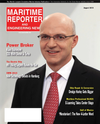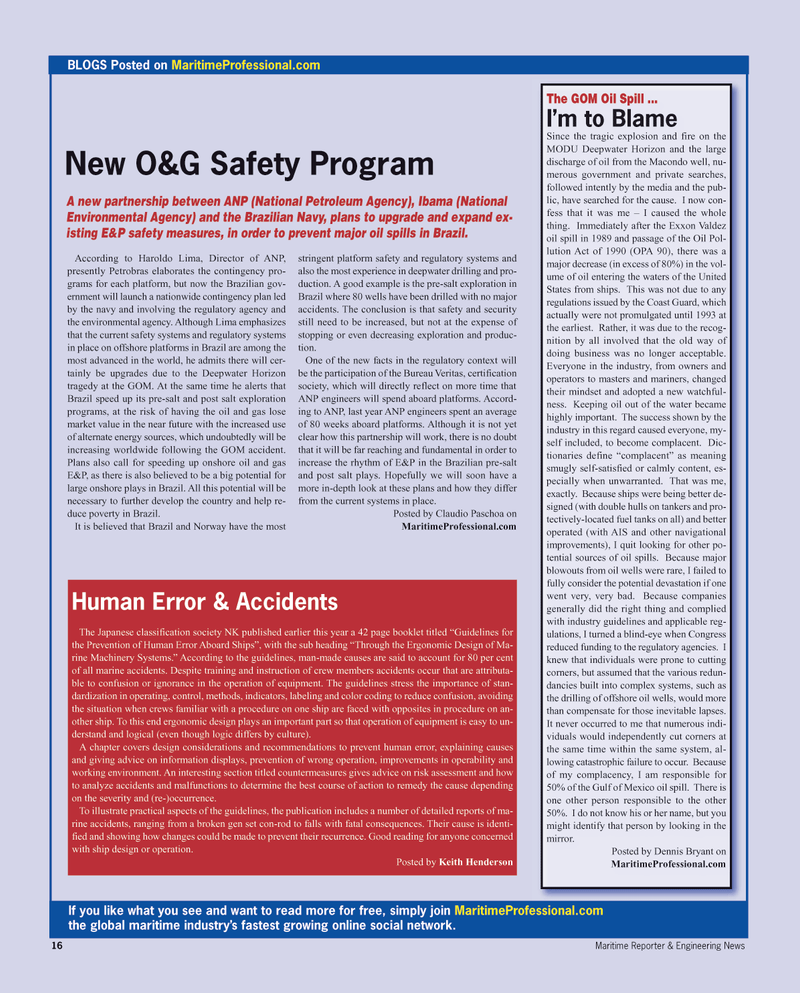
Page 16: of Maritime Reporter Magazine (August 2010)
The Electric Ship
Read this page in Pdf, Flash or Html5 edition of August 2010 Maritime Reporter Magazine
16 Maritime Reporter & Engineering News
According to Haroldo Lima, Director of ANP, presently Petrobras elaborates the contingency pro- grams for each platform, but now the Brazilian gov- ernment will launch a nationwide contingency plan led by the navy and involving the regulatory agency and the environmental agency. Although Lima emphasizes that the current safety systems and regulatory systems in place on offshore platforms in Brazil are among the most advanced in the world, he admits there will cer- tainly be upgrades due to the Deepwater Horizon tragedy at the GOM. At the same time he alerts that
Brazil speed up its pre-salt and post salt exploration programs, at the risk of having the oil and gas lose market value in the near future with the increased use of alternate energy sources, which undoubtedly will be increasing worldwide following the GOM accident.
Plans also call for speeding up onshore oil and gas
E&P, as there is also believed to be a big potential for large onshore plays in Brazil. All this potential will be necessary to further develop the country and help re- duce poverty in Brazil.
It is believed that Brazil and Norway have the most stringent platform safety and regulatory systems and also the most experience in deepwater drilling and pro- duction. A good example is the pre-salt exploration in
Brazil where 80 wells have been drilled with no major accidents. The conclusion is that safety and security still need to be increased, but not at the expense of stopping or even decreasing exploration and produc- tion.
One of the new facts in the regulatory context will be the participation of the Bureau Veritas, certification society, which will directly reflect on more time that
ANP engineers will spend aboard platforms. Accord- ing to ANP, last year ANP engineers spent an average of 80 weeks aboard platforms. Although it is not yet clear how this partnership will work, there is no doubt that it will be far reaching and fundamental in order to increase the rhythm of E&P in the Brazilian pre-salt and post salt plays. Hopefully we will soon have a more in-depth look at these plans and how they differ from the current systems in place.
Posted by Claudio Paschoa on
MaritimeProfessional.com
If you like what you see and want to read more for free, simply join MaritimeProfessional.com the global maritime industry’s fastest growing online social network.
BLOGS Posted on MaritimeProfessional.com
The GOM Oil Spill ...
I’m to Blame
Since the tragic explosion and fire on the
MODU Deepwater Horizon and the large discharge of oil from the Macondo well, nu- merous government and private searches, followed intently by the media and the pub- lic, have searched for the cause. I now con- fess that it was me – I caused the whole thing. Immediately after the Exxon Valdez oil spill in 1989 and passage of the Oil Pol- lution Act of 1990 (OPA 90), there was a major decrease (in excess of 80%) in the vol- ume of oil entering the waters of the United
States from ships. This was not due to any regulations issued by the Coast Guard, which actually were not promulgated until 1993 at the earliest. Rather, it was due to the recog- nition by all involved that the old way of doing business was no longer acceptable.
Everyone in the industry, from owners and operators to masters and mariners, changed their mindset and adopted a new watchful- ness. Keeping oil out of the water became highly important. The success shown by the industry in this regard caused everyone, my- self included, to become complacent. Dic- tionaries define “complacent” as meaning smugly self-satisfied or calmly content, es- pecially when unwarranted. That was me, exactly. Because ships were being better de- signed (with double hulls on tankers and pro- tectively-located fuel tanks on all) and better operated (with AIS and other navigational improvements), I quit looking for other po- tential sources of oil spills. Because major blowouts from oil wells were rare, I failed to fully consider the potential devastation if one went very, very bad. Because companies generally did the right thing and complied with industry guidelines and applicable reg- ulations, I turned a blind-eye when Congress reduced funding to the regulatory agencies. I knew that individuals were prone to cutting corners, but assumed that the various redun- dancies built into complex systems, such as the drilling of offshore oil wells, would more than compensate for those inevitable lapses.
It never occurred to me that numerous indi- viduals would independently cut corners at the same time within the same system, al- lowing catastrophic failure to occur. Because of my complacency, I am responsible for 50% of the Gulf of Mexico oil spill. There is one other person responsible to the other 50%. I do not know his or her name, but you might identify that person by looking in the mirror.
Posted by Dennis Bryant on
MaritimeProfessional.com
New O&G Safety Program
A new partnership between ANP (National Petroleum Agency), Ibama (National
Environmental Agency) and the Brazilian Navy, plans to upgrade and expand ex- isting E&P safety measures, in order to prevent major oil spills in Brazil.
Human Error & Accidents
The Japanese classification society NK published earlier this year a 42 page booklet titled “Guidelines for the Prevention of Human Error Aboard Ships”, with the sub heading “Through the Ergonomic Design of Ma- rine Machinery Systems.” According to the guidelines, man-made causes are said to account for 80 per cent of all marine accidents. Despite training and instruction of crew members accidents occur that are attributa- ble to confusion or ignorance in the operation of equipment. The guidelines stress the importance of stan- dardization in operating, control, methods, indicators, labeling and color coding to reduce confusion, avoiding the situation when crews familiar with a procedure on one ship are faced with opposites in procedure on an- other ship. To this end ergonomic design plays an important part so that operation of equipment is easy to un- derstand and logical (even though logic differs by culture).
A chapter covers design considerations and recommendations to prevent human error, explaining causes and giving advice on information displays, prevention of wrong operation, improvements in operability and working environment. An interesting section titled countermeasures gives advice on risk assessment and how to analyze accidents and malfunctions to determine the best course of action to remedy the cause depending on the severity and (re-)occurrence.
To illustrate practical aspects of the guidelines, the publication includes a number of detailed reports of ma- rine accidents, ranging from a broken gen set con-rod to falls with fatal consequences. Their cause is identi- fied and showing how changes could be made to prevent their recurrence. Good reading for anyone concerned with ship design or operation.
Posted by Keith Henderson

 15
15

 17
17
